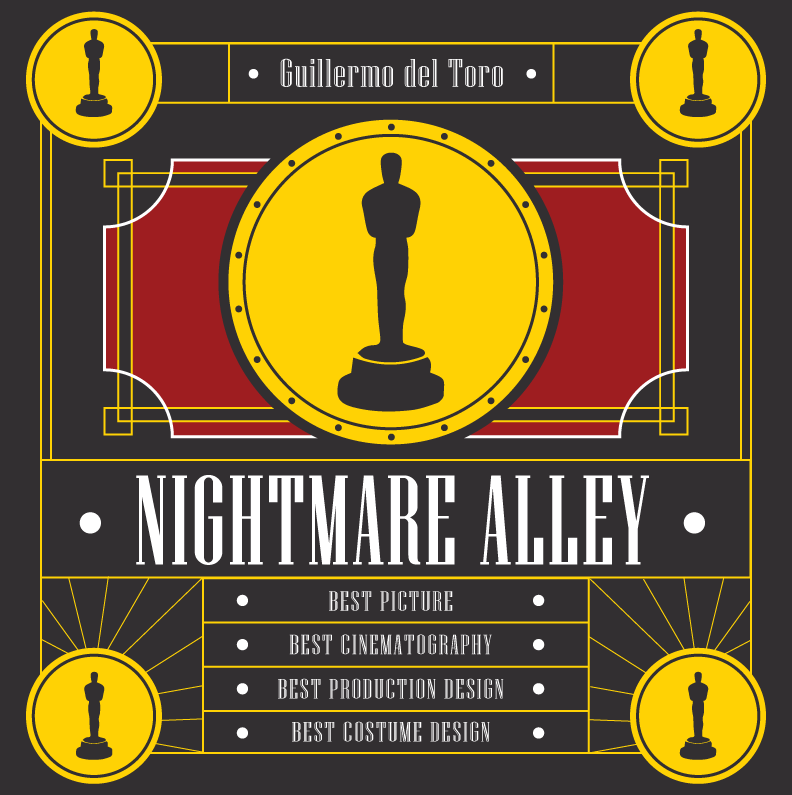Oscar review: The hazy thrills of ‘Nightmare Alley’
March 2, 2022
It is once again Oscar season. Along with it comes much discussion and speculation, mostly regarding the “best” film of the year but often shedding a light on some of the hidden gems. Among the expansive list of best picture nominees lies an intricately woven web of drama and deception, otherwise known as “Nightmare Alley.”
Released in December and directed by Guillermo del Toro, the film focuses on Stanton Carlisle, a skilled con man with some mysteriously well-kept secrets. Carlisle is joined by an ensemble of interesting characters, including a scheming psychiatrist, Dr. Lilith Ritter, and a veteran mental magician, Pete. “Nightmare Alley” also uses the talent of some remarkable actors, with Bradley Cooper as Carlisle, Willem Dafoe as Clem Hoatley, David Strathairn as Pete and Cate Blanchett as Dr. Ritter. Despite not appearing on screen until around halfway through, Dr. Ritter proves to be an equally skilled opponent for Carlisle. Until this point, the audience is left to wonder where Carlisle is heading and whether those he meets along the way will inspire or corrupt him.
From the first five minutes of “Nightmare Alley,” it becomes clear the story heads down a dangerous path. The awareness of the film’s true nature sticks with viewers throughout, setting the stage for interesting moral conundrums that seemingly only intensify. Because of this, the film feels like watching a slow motion car wreck over the course of two hours. Although it may be tempting to look away, the film’s distinctly wicked characters with a flair for trickery add up to an Oscar-worthy wonder that is set on redefining the noir genre for a modern audience.
Set in the 1940s, “Nightmare Alley” embodies the world during the period. For the first half of the movie, the audience is plunged into the lives of deceitful circus workers. While this section serves as the slightly more tame chapter of the film, it’s a crucial stepping stone for Carlisle as he works to restart his life with equally peculiar acquaintances. Among his fellow performers are Dafoe’s Clem Hoatley and Collette’s Zeena, both of which set a low bar regarding the film’s moral compass. As “Nightmare Alley” progresses, so does Carlisle as he graduates from circus acts to becoming a professional mentalist, dealing with much more esteemed, yet dangerous, clientele.
From the world of the circus to the grittiness of a New York-esque city, del Toro makes a clear distinction between pure drama and noir. These settings act as a fuel for the film, motivating the movement of the story from one encampment to the next. Often drawing on tactics from some of the most renowned noir films, such as “The Harder They Fall” from 1956, “Nightmare Alley” takes audiences back in the true fashion of a period piece. Every design aspect – from costumes to grimy set details, to the hazy atmosphere, to abundant cigarette smoking – contributes to the original, classical style of a noir film.
Being a drama at heart, there are plentiful amounts of intriguing dialogue throughout the film. Characters who are seemingly nothing alike come into contact and eventually reveal each other’s true cynicism in ways that are both heinous and grand. At other times, the movie reveals the nature of the characters early on, leaving the audience glued to their seats as they await inevitable self-destruction. This film is a slow burn, being careful to only provide information necessary for the moment. Eventually, though, as these moments build on one another and escape paths dwindle, “Nightmare Alley” suffocates its audience through the characters. As Carlisle climbs and the plot intensifies, viewers are forced to spectate as the film’s grip only tightens, leading to a release that is unavoidable yet justified.
One key reason this intensity works is because of the stakes at hand. Although infrequent, this movie includes some unsettling violence. Similar to 2019’s “Joker,” this film is careful not to overload the audience with violence. When implemented; however, it is unforgettable. “Nightmare Alley” uses uncertainty to its advantage as it clarifies its morally ambiguous stance, serving as a brief reminder for viewers of where this film lies.
Being a Best Picture nominee, “Nightmare Alley” is quite remarkable, though it won’t adhere to everyone’s taste. It is slow yet methodical in its approach, keeping viewers invested with the dialogue above all else. Those who gravitate toward classical noir films will be more inclined to see “Nightmare Alley,” though, it is enjoyable without this specific movie tendency. While it may not be praised for spectacle, there is no denying “Nightmare Alley” thrives as a noir film. Carried by a star-studded cast and director, this tale is all about self-absorption, told for today’s audience. Having managed to effectively sell its world to its audience and tell a story as chilling as it is impressive, “Nightmare Alley” makes a convincing argument for why it deserves Best Picture and why noir films never died. “Nightmare Alley” gets an 8.4/10.

















